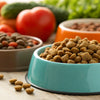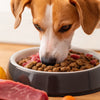Is Kibble or Raw Food Better for Dogs? A Comprehensive Guide for Pet Owners
- Houndsy
Table of Contents
- Introduction
- The Evolution of Dog Food
- Understanding Kibble: Ingredients and Nutritional Content
- Exploring Raw Food Diets: Benefits and Risks
- Making the Right Choice for Your Dog
- Houndsy’s Commitment to Elevating the Feeding Experience
- Conclusion
Introduction
Did you know that the pet food industry has exploded in recent years, with raw diets gaining significant popularity among pet owners? As dog lovers, we often find ourselves pondering the age-old question: "Is kibble or raw food better for dogs?" This question isn't just about what our furry companions eat; it's about their overall health, happiness, and longevity. With the myriad of options available today, making an informed decision can be overwhelming.
In this blog post, we'll dive deep into the debate surrounding kibble and raw food diets. We aim to provide you with a balanced perspective, helping you understand the benefits and drawbacks of each option. By the end of this article, you'll have a clearer idea of which feeding method might be best for your beloved pet.
We’ll explore the history of dog food, the nutritional composition of kibble versus raw diets, and key considerations for your dog’s health. We will also touch upon our commitment at Houndsy to enhance the feeding experience, ensuring that mealtime is not only nutritious but also enjoyable for both pets and their owners.
So, let’s embark on this journey together and see how we can elevate our dog-feeding rituals while making informed choices!
The Evolution of Dog Food
To understand the current landscape of dog food, we need to look back at its history. The first commercial dog food was introduced in the 1920s, but before that, dogs were primarily fed scraps and leftovers from human meals. As our understanding of canine nutrition evolved, so did the products available on the market.
Kibble: The Staple of Pet Food
Kibble, also known as dry dog food, became a household name due to its convenience and affordability. It is produced through a process called extrusion, where ingredients like meat, grains, and vegetables are cooked and then shaped into bite-sized pieces. This process not only preserves the food but also extends its shelf life.
While kibble has become synonymous with dog food, it is essential to recognize that not all kibble is created equal. The quality of ingredients, nutritional balance, and manufacturing practices can vary significantly across brands.
Rise of Raw Diets
The raw food movement, often referred to as the BARF diet (Biologically Appropriate Raw Food), has gained traction in recent years. Proponents of raw feeding argue that it mimics the natural diet of dogs, promoting better health and vitality. Raw diets typically consist of raw meat, bones, fruits, vegetables, and sometimes eggs and dairy.
As pet owners become more conscious of their dogs' diets, the interest in raw feeding continues to grow, prompting us to consider the implications of these dietary choices.
Understanding Kibble: Ingredients and Nutritional Content
When evaluating whether kibble is the right choice for your dog, it’s crucial to understand its core components.
Composition of Kibble
Kibble is primarily composed of:
- Protein Sources: Typically includes meat, poultry, or fish, which should be the first ingredient listed.
- Carbohydrates: Often derived from grains like corn, wheat, or rice, as well as potatoes or peas. While dogs can digest carbohydrates, they are not a biological necessity.
- Fats: Essential for energy and skin health, these should come from high-quality sources.
- Vitamins and Minerals: Added to ensure the food is nutritionally balanced and meets the AAFCO (Association of American Feed Control Officials) guidelines.
Pros and Cons of Kibble
Pros
- Convenience: Kibble is easy to store, measure, and serve, making it a hassle-free option for busy pet owners.
- Cost-Effective: Generally more affordable than raw diets, making it accessible for most households.
- Long Shelf Life: Kibble can be stored for months without spoiling, which is ideal for those who may not have the ability to purchase fresh food regularly.
Cons
- Quality Variability: Not all kibble brands use high-quality ingredients. Some may include fillers or artificial additives that can be detrimental to your dog’s health.
- Low Moisture Content: Kibble typically contains around 10% moisture, which may lead to dehydration if not balanced with adequate water intake.
- Processing Concerns: The high-temperature cooking process can destroy some nutrients and alter the food’s natural composition.
Exploring Raw Food Diets: Benefits and Risks
Now that we’ve established the basics of kibble, let’s delve into the raw food diet and its implications for your pet's health.
Composition of Raw Diets
A typical raw dog food diet may include:
- Muscle Meat: The primary protein source, often including cuts of beef, chicken, or lamb.
- Bones: Raw, edible bones provide essential calcium and phosphorus.
- Organs: Liver and other organ meats are crucial for a balanced diet and offer various vitamins and minerals.
- Fruits and Vegetables: These add fiber and essential nutrients, supporting overall health.
- Supplements: Some raw diets may include additional supplements for balanced nutrition.
Pros and Cons of Raw Feeding
Pros
- Nutrient Density: Raw diets often retain higher levels of essential nutrients compared to processed kibble, potentially leading to improved energy levels and coat condition.
- Better Digestion: Many dogs on raw diets experience improved digestion and fewer gastrointestinal issues, as raw food is easier for them to break down.
- Natural Ingredients: Raw diets often contain fewer additives and preservatives, which can lead to a more natural feeding experience.
Cons
- Bacterial Contamination: Raw meat can harbor harmful bacteria like Salmonella and E. coli, posing health risks to both pets and humans.
- Nutritional Imbalance: Without proper formulation, homemade raw diets can lead to serious nutritional deficiencies, which can severely impact your dog's health.
- Preparation Time: Preparing raw food can be time-consuming and requires careful handling to avoid contamination.
Making the Right Choice for Your Dog
As pet owners, we must weigh the benefits and risks of both kibble and raw diets to determine the best feeding approach for our furry friends. Here are some factors to consider:
1. Your Dog’s Health and Age
Diverse dietary needs exist based on age, breed, and health conditions. Puppies may benefit from the balanced nutrition provided by high-quality kibble, while active adult dogs might thrive on a raw diet. Always consult your veterinarian for personalized recommendations tailored to your dog's specific health needs.
2. Lifestyle and Convenience
Consider your lifestyle and how much time you can dedicate to meal preparation. If you lead a busy life, kibble might be the more practical choice. However, if you’re committed to preparing fresh meals for your dog, raw feeding can offer numerous benefits.
3. Budget
Cost is always a consideration. Kibble tends to be more budget-friendly, while raw diets can be more expensive due to the quality of ingredients and preparation.
4. Quality of Ingredients
If you choose kibble, prioritize high-quality brands that use real, identifiable ingredients. Avoid those with fillers, by-products, and artificial additives. A premium kibble can offer balanced nutrition without the downsides of poorly formulated options.
Houndsy’s Commitment to Elevating the Feeding Experience
At Houndsy, we believe that feeding should be a joyful and enriching experience for both pets and their owners. Our flagship product, the Houndsy Kibble Dispenser, exemplifies our dedication to convenience, quality, and design excellence.
Features of the Houndsy Kibble Dispenser
- Ergonomic Design: Our dispenser features a convenient crank handle at standing height, eliminating the need for bending and reducing strain during feeding.
- Perfect Portion Control: Say goodbye to overfeeding with our precise measuring system that ensures your dog gets the right amount every time.
- Elegant Aesthetics: The mid-century modern design not only enhances your home decor but also makes feeding a stylish affair.
- Large Storage Capacity: With the ability to hold 25–30 lbs of kibble, you can ensure you have enough food on hand without frequent trips to the store.
- BPA-Free Liner: Our high-quality materials ensure that your dog’s food stays fresh and safe from harmful chemicals.
By integrating our Houndsy Kibble Dispenser into your feeding routine, you can simplify your daily pet care tasks while elevating your dog's feeding experience. Explore the Houndsy Kibble Dispenser here.
Conclusion
Ultimately, whether you choose kibble or raw food for your dog, the key is to prioritize their health and well-being. Both feeding methods offer unique benefits and challenges, and the decision should be made based on careful consideration of your pet's individual needs, your lifestyle, and your budget.
As pet parents, we have the privilege and responsibility to provide the best for our furry companions. By staying informed and making conscious choices, we can ensure that our dogs lead happy, healthy lives.
Feel free to share your experiences or questions about dog feeding in the comments below. And, if you're looking to enhance your dog feeding routine, don't forget to check out the Houndsy Kibble Dispenser here.
FAQ
1. Is kibble better than raw food for dogs? The answer depends on your dog's individual needs, lifestyle, and preferences. High-quality kibble offers convenience and balanced nutrition, while raw diets can provide more nutrients but come with risks.
2. Can I mix kibble and raw food? Yes, many pet owners choose to mix both diets to provide variety and balance. However, it's essential to monitor your dog's health and consult with a veterinarian for guidance.
3. How can I ensure my dog gets a balanced diet? Regardless of the diet you choose, ensure that it meets AAFCO standards and is formulated to provide complete nutrition. Consulting with your veterinarian can help tailor the diet to your dog's specific needs.
4. What are the risks associated with raw feeding? Raw diets can pose risks such as bacterial contamination and nutritional imbalances if not carefully formulated. It's crucial to handle raw food with care and seek guidance from a veterinarian.
5. How can I transition my dog to a new diet? Gradually introduce the new food over several days, mixing it with the current diet to avoid gastrointestinal upset. Monitor your dog’s response and consult your veterinarian if you have concerns.













